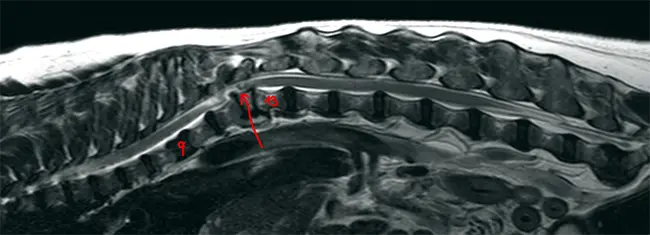Dexter has become a regular face at Kentdale Referrals over the last two years. We initially saw him in 2022 for back problems, which were treated with rest and pain medication. However, he came back to us in March 2023 with hindlimb weakness and incoordination. An MRI scan of his back was performed which revealed bowing of the spine (kyphosis), narrowing of the spinal canal with flattening of the spinal cord, and formation of a cyst in the spinal cord.

French Bulldogs are unfortunately prone to malformations of the bones in their spine called hemivertebra. The hemivertebra (wedge-shaped vertebra) can be associated with abnormal curvatures of the vertebral column, such as kyphosis and scoliosis. Their presence increases the risk of other spinal disorders, such as intervertebral disc disease. Some affected dogs can develop clinical signs directly related to the hemivertebra. Neurological deficits result in gradually progressive symmetric non-painful paresis (weakness) and ataxia (incoordination) of the back legs.

Treatment of the thoracic hemivertebra with kyphosis is challenging. A recent research study has revealed that medical management is unfortunately associated with a poor outcome and better outcomes are seen with surgery. The disease mechanism of thoracic kyphosis is multifactorial; however, vertebral micro-instability is considered an important factor. Good results have been obtained by stabilisation with or without partial realignment of the vertebral column. Stabilising surgery is designed to stop progressive deterioration of spinal function; however, some patients can improve after surgery in terms of hind limb strength and coordination.

Complex spinal malformations can now be treated by state-of-the-art surgery, which uses 3D printing technology. This technology uses the CT-scan of the individual patient to generate a replica of the affected vertebral column and custom-made 3D-printed drill guides. These 3D-printed drill guides are designed to match the specific anatomy of each individual vertebra and follow the ideal trajectory for implant placement.
Dexter’s CT scan was booked on 11th April 2023 for modelling of the drill guide. Two weeks later the surgeons at Kentdale performed stabilisation surgery spanning 5 thoracic vertebrae. This incredibly complex procedure took more than 4 hours and Dexter was closely monitored throughout by the expert nursing team. A postoperative CT scan was performed which showed excellent placement of all the implants. Dexter recovered from anaesthesia overnight and was able to walk the next day after his highly technically demanding surgery. After a few days spent in hospital being looked after around the clock, Dexter returned to his usual self and was discharged home to follow a physiotherapy plan to help regain normality. He visited our dedicated physiotherapist regularly over the next 18 months and made steady progress.
Physiotherapy is a vital part of the recovery for these patients following complex spinal procedures, and his owner’s dedication paid off with the improvements we saw in Dexter’s mobility.
Contact Kentdale Vets for more information about our services.











